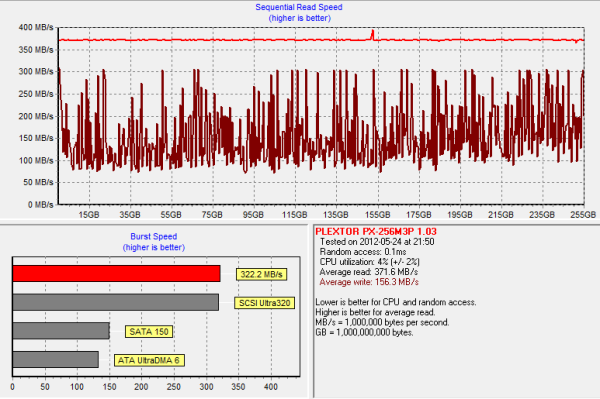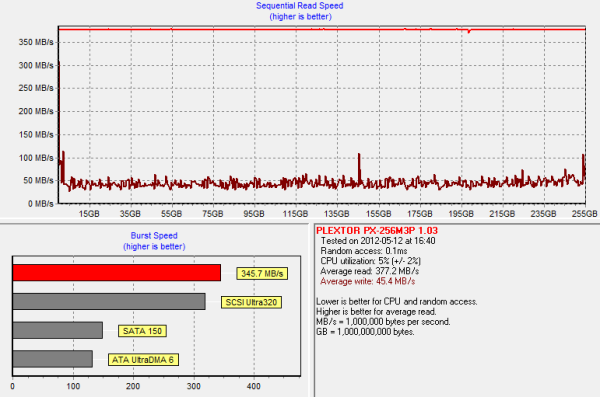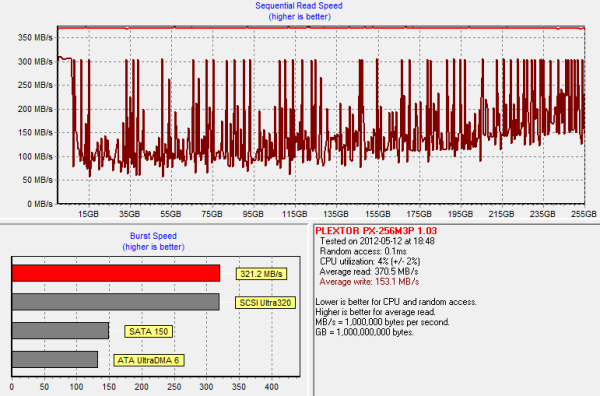Plextor M3 Pro (256GB) Review
by Kristian Vättö on July 1, 2012 1:45 PM ESTPerformance Over Time and TRIM
The M3 Pro is also equipped with Plextor's "True Speed" technology, which we found to be fairly effective when testing the M3. Hence we should expect the M3 Pro to do well in this aspect as well. To get the base-level performance, I ran HD Tach once on a clean drive:
The first step in our torture testing is 20 minutes of 4KB random writes (QD=32, 100% LBA space) ran on a full drive:
As with the M3, 20 minutes of torturing is nowhere enough to put the M3 Pro at its worst state. The average write performance is still 156MB/s, although it does drop to as low as 70-80MB/s for some LBAs.
Next I secure erased the drive and ran our torture test for 60 minutes:
And that's more like it. Average performance has dropped to 45MB/s and there are only three +100MB/s peaks. This was expected as the M3 experienced similar behavior.
I let the drive idle for an hour and 40 minutes after 60 minutes of torture and a single pass of HD Tach, and here's what the performance looked like:
Performance does recover pretty nicely with some idle time and sequential writes. Write speed is still nowhere near clean state performance but it has more than tripled when compared to the dirty state after 60 minutes of torturing.
Finally I TRIM'ed the drive to make sure that TRIM functions properly, and it does:
Overall the M3 Pro should be a good option, even if you're using an OS without official TRIM support (such as OS X). If you're running an OS with TRIM support, then there is obviously nothing to worry about as TRIM functions perfectly. TRIM can nowadays be enabled in OS X for third party drives as well, so there is even less to worry about. If you don't want to have TRIM enabled all the time (due to stability issues for example), you can enable it temporarily and TRIM the drive by secure erasing free space in Disk Utility. After that you can simply disable TRIM and you are left with a TRIM'ed SSD.















55 Comments
View All Comments
fausto412 - Sunday, July 1, 2012 - link
I am almost settled on Samsung 830 but even the capacity becomes an issue.256gb is what I want but that price is more than I want to pay.
Can someone explain how TRIM works?
My windows drive is fine with Battlefield 3 and Bad Company 2 installed...it is the media files that need relocation. I have read I can change the my pictures and my videos system folder locations.
jwilliams4200 - Sunday, July 1, 2012 - link
Can someone explain how to use google to find the answers to basic questions?Belard - Monday, July 2, 2012 - link
go to your browser, type in G O O G L E . C O M (each letter is a key) and press enter key.Faustso: buy a smaller drive for your OS and work Apps (MS Office) and use a HD for your games and videos and porn. Also use the HD to store an image of the SSD in case of failure.
iwod - Sunday, July 1, 2012 - link
Looks like we need 12Gbps ASAP. The Firmware design are starting to bring in less improvement %. And Idle / Active Power consumption needs to stay low as well.Belard - Monday, July 2, 2012 - link
PCI-e Drives are for that. But its stupid that none or most are non-bootable.mayankleoboy1 - Monday, July 2, 2012 - link
can you do a re-review of vertex4 120GB with the newly released 1.4 firmware?macuser2134 - Monday, July 2, 2012 - link
+1. You absolutely need to do this ASAP. Vertex 4 with the latest firmware update needs to be re-tested and updated in the AnandTech storage bench.iceman98343 - Monday, July 2, 2012 - link
you are late. vertex 4 1.5beta was released on Friday.casteve - Monday, July 2, 2012 - link
"I find it to be more hassle to put the drive inside an enclosure than to simply secure erase the drive with other methods."Buy an eSATA bracket with power for $10 from your favorite e-tailer.
NCM - Monday, July 2, 2012 - link
Based on the previous favourable review of the Plextor I bought and installed a 256GB M3 (plain) as the boot/app drive in a new Mac Pro workstation a couple of months ago, with TRIM turned on for this non-Apple drive via the Trim Enabler freeware utility. Most files are stored on our server, so capacity isn't really an issue. However I've found that our 128GB drives stand to run somewhat full, so 256GB gives plenty of storage headroom.It's been running very satisfactorily, with the responsiveness you'd expect of an SSD machine.
Just last week I bit the bullet and bought a 512GB M3 Pro for my own 13" MacBook Pro. The slight extra cost of the M3 Pro isn't meaningful in an almost $700 drive, so I saw no reason not to get the better version. I preferred the Marvell controller over Sandforce due to the incompressible data performance, and chose Plextor over a Samsung 830 due to lower power consumption in the laptop application.
My original 500GB conventional drive contains over 300GB, and while it might have been possible to prune that enough to squeeze into a 256GB, the SSD would then have run very full, affecting SSD garbage collection/TRIM. It's also necessary to leave enough free space for the hibernation RAM image, as well as for VM pages. So the 512GB version it was.
The process is straightforward. I used Apple's Disk Utility to clone the existing drive to the Plextor mounted in a Newer Tech external FW800 dock, test booted, then installed it in the MBP. TRIM is enable as above.
Performance improvement is as you'd hope, particularly since the original drive was only 5400 rpm. Another upside is the shock resistance of an SSD for mobile applications.
The only real downside is the hole-in-the-wallet effect!